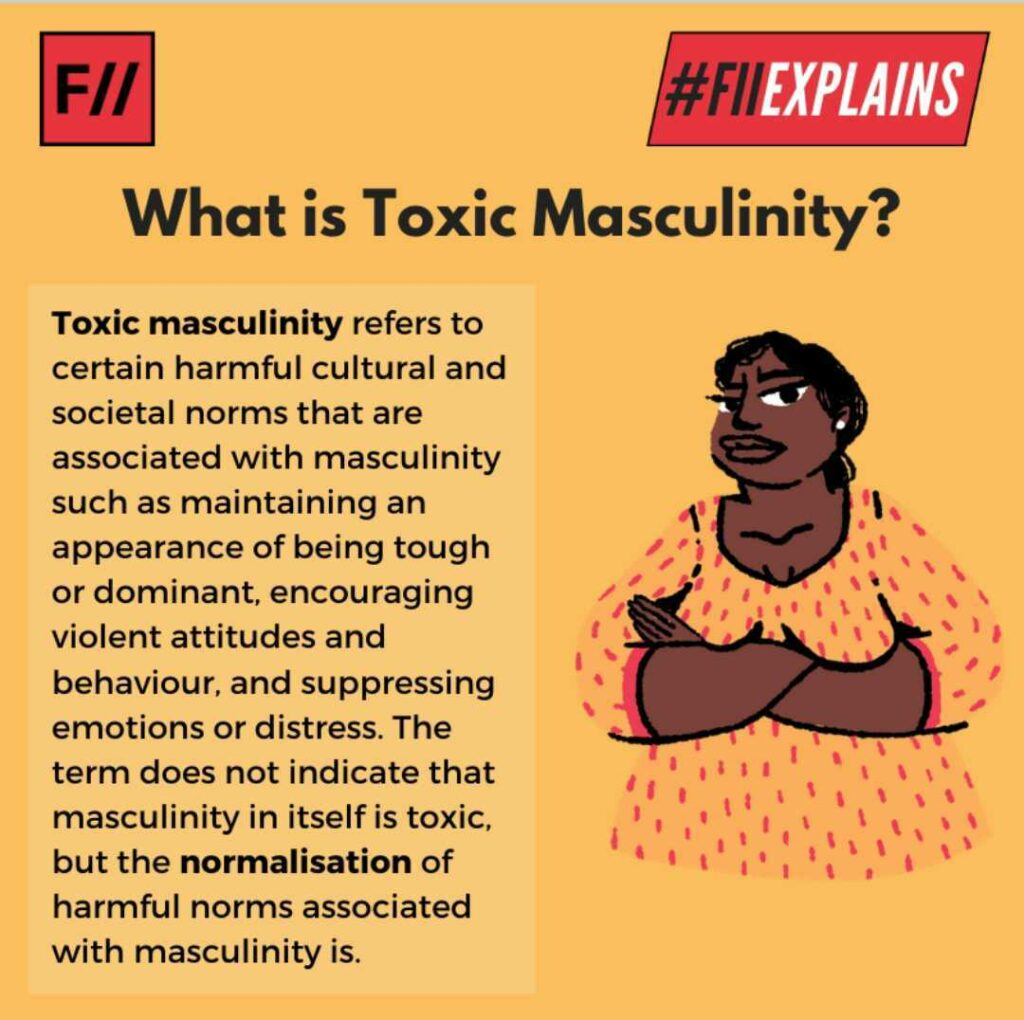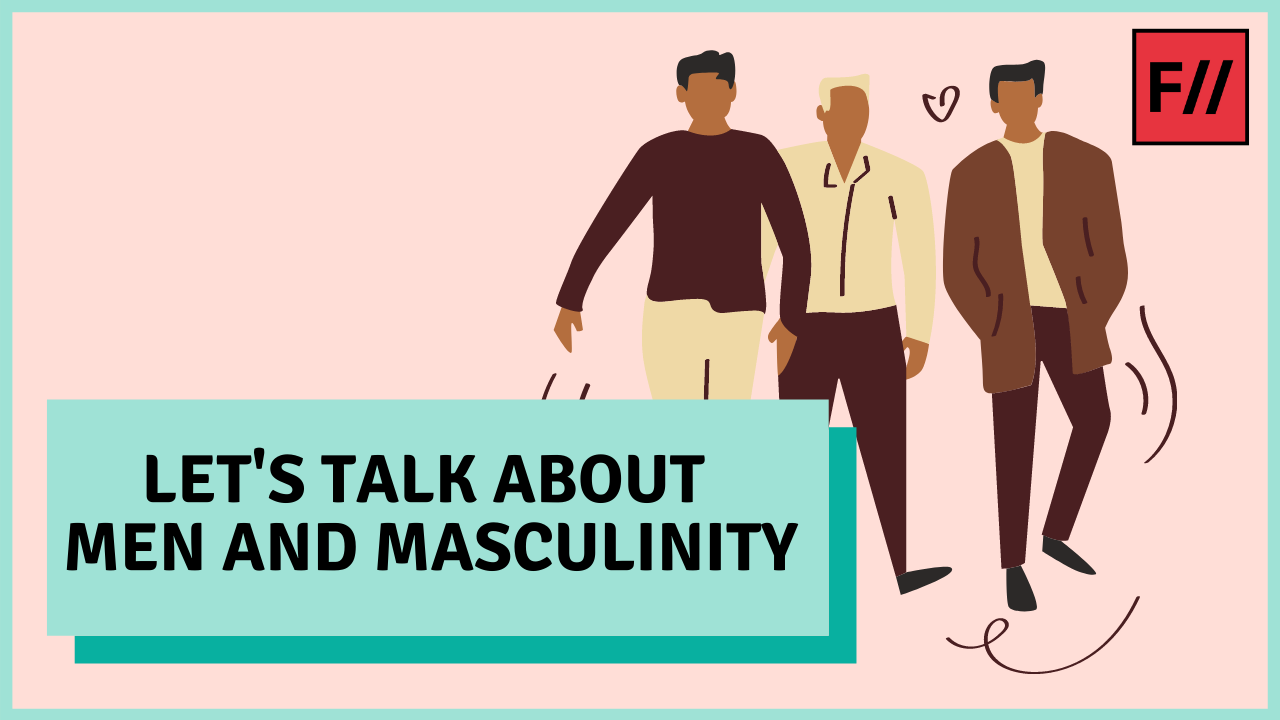Toxic Masculinity is a set of attitudes and behaviors culturally associated with or expected of men that emphasises strength, virility, and domination to assert power. It stems from the society’s patriarchal definition of “manliness” which mandates that men must perform their gender in ways that reflect steadfastness and antifemininity. Men must act tough, especially tougher than women and other genders who are perceived as ‘weak and emotional‘.
Masculinity is not toxic in and of itself, but certain socially regressive qualities that are labeled as “manly” have massive repercussions for men and the society, leading to the manifestation of “toxic masculinity.”

Origins of toxic masculinity
The majority of what many people consider masculinity arose thousands of years ago, when early Homo sapiens used strength, for example, to impose authority over others. Men who could fight and hunt were the most successful. Aggression, ruthlessness, and physical power were the most valued attributes at the time. These customs persisted for generations, contributing to the restricted definition of masculinity.
It can appear in subtle ways that you may not even notice. Telling someone to “man up,” or hide their feelings, implies that vulnerability is “unmanly.” “Boys will be boys,” as the cliché goes, excuses young males’ irresponsible and destructive behavior. Another widespread belief is that guys are not expected to be good communicators as suggested by “I’m a guy, we’re not good at that stuff!“. The expression “no homo” implies that showing affection for a male friend is anti-masculine. All these ideas work together to create a self image in men that is ultimately destructive to themselves and other genders
However, during the 1980s and 1990s, conventional masculine habits became incompatible with the society’s evolving values. Traditional conceptions of masculinity become obsolete as attitudes toward certain male behaviors changed. The advent of technology combined with globalisation also made physical strength irrelevant, because manual labour began to be replaced by machines, and there was no longer any need to conquer and dominate for basic survival.
Regrettably, many communities and cultures still continue to practice these ‘supposed norms,’ which coerce men and others around them to confirm to archaic notions of masculinity. Toxic masculinity arises from the demand for males to be a certain way, as prescribed by gender roles that are centuries old.

What does toxic masculinity look like?
Toxic masculinity is more than just blatant displays of aggressiveness and intolerance. It is difficult to pinpoint a single instance of toxic masculinity because the definition of masculinity differs among cultures, religions, and social classes. However, all societal narratives of ‘manliness‘ revolve around the idea that masculinity is defined by strength, lack of emotion, self-sufficiency, dominance, and sexual virility.
Toxic masculinity is characterised by an overemphasis on hyper-competitiveness, an inclination for or glorifying violence, entitlement, chauvinism, homophobia, transphobia, and other traits. Furthermore, it is linked to anti femininity, a negative attitude toward seeking help, and dangerous behaviors such as heavy drinking and tobacco use.
Also read: The Perils & Price Of Performing Toxic Masculinity
It can appear in subtle ways that you may not even notice. Telling someone to “man up,” or hide their feelings, implies that vulnerability is “unmanly.” “Boys will be boys,” as the cliché goes, excuses young males’ irresponsible and destructive behavior. Another widespread belief is that guys are not expected to be good communicators as suggested by “I’m a guy, we’re not good at that stuff!“. The expression “no homo” implies that showing affection for a male friend is anti-masculine. All these ideas work together to create a self image in men that is ultimately destructive to themselves and other genders.
Effects on men and the society
Toxic masculinity is frequently perceived as only damaging to others. However it is men who are the first victims. Both those who cling to traditional masculinity and those who do not, experience negative consequences of it.
Toxic masculinity pressurises men to behave in a certain way. The need to remain stoic and be a good provider can lead men to chronic stress, hypertension, depression and anxiety. Men are at risk of substance abuse, suicide, and psychological damage since freely discussing emotions runs against to traditional masculine standards. Furthermore, for fear of appearing weak, they are less likely to seek professional help for physical and mental health.
Toxic masculinity concept tends to treat cisgender women as sexual conquests, reinforcing rape culture. It also attempts to shift blame away from sexual offenders and towards the survivor. It also teaches men that using hostility and violence to solve problems is appropriate. Usually, women and trans individuals are the targets of men who get violent. As a result, we frequently see domestic violence, sexual assault, gun violence, acid attacks, and other forms of toxic masculinity-fueled violence
This puts a burden on the men who lacks these “masculine” characteristics. Men who act in ways that contradict these limiting viewpoints may feel inadequate and weak. They are seen as “lesser males” and are socially shunned. Those who don’t fit into the established box of what it means to be masculine, especially among adolescents and teenagers, may be rejected as a result. Boys of all races and ethnic backgrounds may face harassment at school if they don’t act “masculine enough,” leading to peer isolation and loneliness.

While toxic masculinity has an impact on individuals, it can also have social consequences. When males are forced to adopt exaggerated masculine characteristics, they strike out in an attempt to reclaim their “manhood”. It can lead to extremely harmful behavior causing threat to the life of others.
Toxic masculinity concept tends to treat cisgender women as sexual conquests, reinforcing rape culture. It also attempts to shift blame away from sexual offenders and towards the survivor. It also teaches men that using hostility and violence to solve problems is appropriate. Usually, women and trans individuals are the targets of men who get violent. As a result, we frequently see domestic violence, sexual assault, gun violence, acid attacks, and other forms of toxic masculinity-fueled violence.
Also read: Why Should We Tolerate Them Man Babies?
Toxic masculinity is destructive since it restricts one’s ability to grow. Many people may find it challenging to question antiquated thinking and go beyond the negative conditioning of traditional and arbitrary gender norms. As a result, while eradicating toxic masculinity will not be easy, it is essential.
There is no single solution to the problem of toxic masculinity because it would demand massive cultural reforms. However, a good first step is to recognise it and understand it. Questioning and working against exaggerated characteristics can help us get out of it. Finally, we must redefine what it is to be a man and instill that perspective in everyone starting at an early age.
About the author(s)
Shawrina is currently doing her honors in English Language and Literature at the East Delta University. She is just dipping her toes into the vast ocean of writing. She is always on the lookout for inspiration from the simple things in life. Her research interests involve anything that makes her wonder about the world around and within her





Many men force their wives to have children against their will, thus turning them into baby producing machines. India should have a strict two child policy. Any man with more than two children must be jailed.
abolition of masculinity and ugliness must come or we will become robots , warning